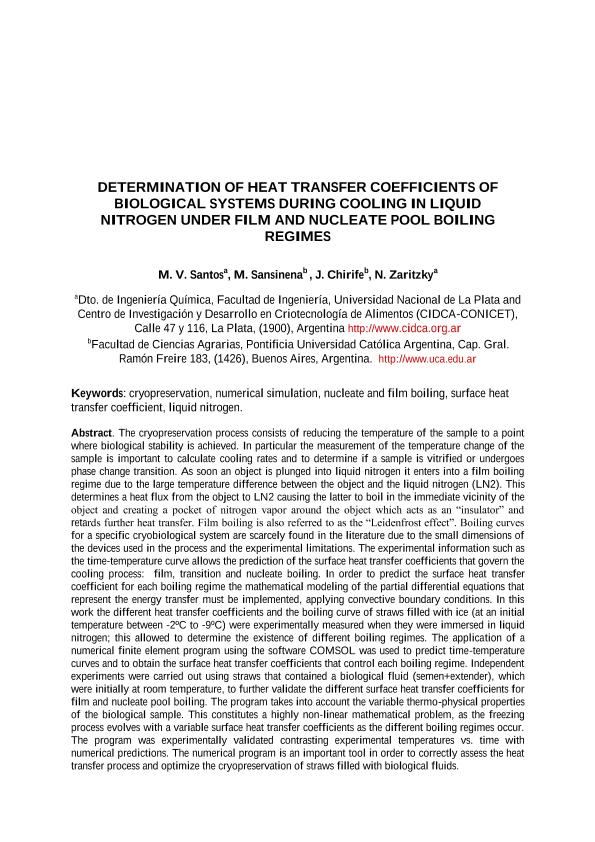Artículo
Determination of heat transfer coefficients of biological systems during cooling in liquid nitrogen under film and nucleate pool boiling regimes
Fecha de publicación:
09/2014
Editorial:
Asociación Argentina de Mecánica Computacional
Revista:
Mecanica Computacional
ISSN:
1666-6070
Idioma:
Inglés
Tipo de recurso:
Artículo publicado
Clasificación temática:
Resumen
The cryopreservation process consists of reducing the temperature of the sample to a point where biological stability is achieved. In particular the measurement of the temperature change of the sample is important to calculate cooling rates and to determine if a sample is vitrified or undergoes phase change transition. As soon an object is plunged into liquid nitrogen it enters into a film boiling regime due to the large temperature difference between the object and the liquid nitrogen (LN2). This determines a heat flux from the object to LN2 causing the latter to boil in the immediate vicinity of the object and creating a pocket of nitrogen vapor around the object which acts as an “insulator” and retards further heat transfer. Film boiling is also referred to as the “Leidenfrost effect”. Boiling curves for a specific cryobiological system are scarcely found in the literature due to the small dimensions of the devices used in the process and the experimental limitations. The experimental information such as the time-temperature curve allows the prediction of the surface heat transfer coefficients that govern the cooling process: film, transition and nucleate boiling. In order to predict the surface heat transfer coefficient for each boiling regime the mathematical modeling of the partial differential equations that represent the energy transfer must be implemented, applying convective boundary conditions. In this work the different heat transfer coefficients and the boiling curve of straws filled with ice (at an initial temperature between -2ºC to -9ºC) were experimentally measured when they were immersed in liquid nitrogen; this allowed to determine the existence of different boiling regimes. The application of a numerical finite element program using the software COMSOL was used to predict time-temperature curves and to obtain the surface heat transfer coefficients that control each boiling regime. Independent experiments were carried out using straws that contained a biological fluid (semen+extender), which were initially at room temperature, to further validate the different surface heat transfer coefficients for film and nucleate pool boiling. The program takes into account the variable thermo-physical properties of the biological sample. This constitutes a highly non-linear mathematical problem, as the freezing process evolves with a variable surface heat transfer coefficients as the different boiling regimes occur. The program was experimentally validated contrasting experimental temperatures vs. time with numerical predictions. The numerical program is an important tool in order to correctly assess the heat transfer process and optimize the cryopreservation of straws filled with biological fluids.
Archivos asociados
Licencia
Identificadores
Colecciones
Articulos(CIDCA)
Articulos de CENTRO DE INV EN CRIOTECNOLOGIA DE ALIMENTOS (I)
Articulos de CENTRO DE INV EN CRIOTECNOLOGIA DE ALIMENTOS (I)
Citación
Santos, Maria Victoria; Sansinena, Marina Julia; Chirife, Jorge; Zaritzky, Noemi Elisabet; Determination of heat transfer coefficients of biological systems during cooling in liquid nitrogen under film and nucleate pool boiling regimes; Asociación Argentina de Mecánica Computacional; Mecanica Computacional; XXXIII; 42; 9-2014; 2759-2771
Compartir




